2 Storyboard
Savvy Start
Title: Helping Your Parent Downsize with Care and Empathy
Summary: This e-learning module is designed to help adult children support their aging parents through the downsizing process. The module provides guidance on emotional readiness, home safety, support systems, financial considerations, and long-term planning.
How I used peers’ feedback to revise prototype/storyboard:
The key takeaway from the feedback I received from my peers was the importance of providing clarity. I realized that I had made assumptions that were clear to me because of my familiarity with the project but were not obvious to others. As a result, the feedback I received was influenced by my lack of clear communication. Therefore, one of the main revisions I made in my previous prototype was to include explanations in the notes section to provide context.
Some things that I learned from the Savvy Start activities:
First, clarity in communication is essential. Misunderstandings during initial presentations highlighted the need to be explicit in explaining concepts, course objectives, and design choices. What seems obvious to me may not be clear to others unfamiliar with the project.
Also, the value of feedback. The feedback I received revealed areas where assumptions about prior knowledge might cause confusion. That helps me be more mindful when creating content. Giving feedback and reviewing others’ projects was just as valuable as receiving it on my own work. Evaluating others’ projects, helped me think critically and provided new perspectives and ideas that I could apply to my own project.
Storyboard Iterations
Helping your parents downsize with care and empathy
Problem: Many adult children feel overwhelmed when supporting aging parents with downsizing. They often lack a structured approach, emotional readiness, and awareness of available resources. This can lead to rushed decisions, family conflict, and increased stress for all involved.
Audience: Adult children who are supporting a parent or older relative through a downsizing transition.
Learning targets:
LT 1: Identify key considerations when supporting a parent through the downsizing process
LT 2: Assess a current living situation to determine downsizing needs and opportunities
LT 3: Develop a personalized downsizing plan that outlines priorities, timelines, and support resources

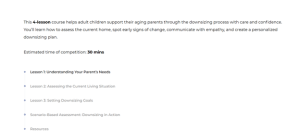
For the module, I used a calm, professional color palette (soft gray and deep navy blue) that sets a reassuring tone.
Based on early user feedback, I included the total number of lessons and an estimated completion time on the course introduction page. This is especially important for my target audience, busy adult children who are often balancing work and personal responsibilities. Providing a clear sense of scope and time commitment helps reduce anxiety. It also supports time management and self-regulation, which are key components of adult learning theory.
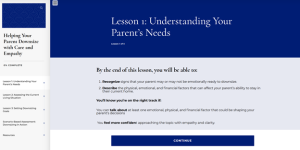
The lesson layout uses Rise 360’s sidebar navigation, which allows learners to track their progress and jump between lessons. This approach supports adult learners who value autonomy and flexibility.
I present the learning objectives using learner-friendly language, rather than overly academic or technical terms. For example, instead of saying “analyze psychosocial and financial readiness,” I wrote, “Recognize signs that your parent may or may not be emotionally ready to downsize.” This makes the goals more relatable.
Finally, I include clear success criteria (“You’ll know you’re on the right track if…”) to help learners self-assess their progress. This kind of transparency builds learner confidence, clarifies expectations, and is rooted in universal design for learning principles. Ensuring learners know exactly what’s expected and how to know they’re succeeding.
Each lesson in the module begins with a consistent structure: a clear title, learner-friendly learning objectives, and success criteria. Creating a sense of cohesiveness and predictability.
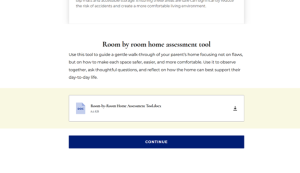
Learners will navigate the course using Rise 360’s built-in interface. They can move forward and backward using “Next” and “Previous” buttons at the bottom of each lesson and access the full lesson list via the sidebar menu on the left. The sidebar also displays completion progress, with a circle next to each lesson that fills in once completed. Learners can return to any previously completed section at any time.
I provide navigational guidance throughout the lessons. I use Continue blocks to help learners pace themselves and complete required activities in order. And throughout the module, I use a light-yellow highlight color to visually cue learners when there is an action to take, such as downloading a resource or completing a worksheet. This intentional use of color helps draw attention without disrupting the calm visual tone of the course.
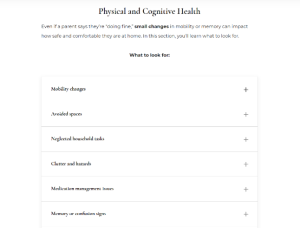
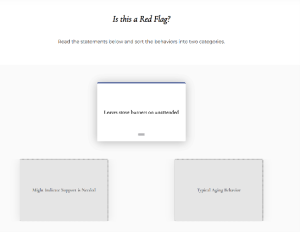

Throughout the module, I use Rise 360’s interactive blocks intentionally to engage learners. For example, accordion blocks (top left) break down topics like physical and cognitive health into manageable, clickable sections. This reduces cognitive load and allows learners to explore at their own pace. I also use flip card blocks (top center) to prompt reflection through gentle, supportive questions.
The sorting activity (top right) encourages application by asking learners to distinguish between typical aging behaviors and red flags that may require support. It transforms passive reading into active decision-making.
In the “Map Your Own 6-Month Downsizing Plan” section (bottom center), I use a labeled graphic block to let learners interact with a timeline and build their own step-by-step plan. This is paired with a downloadable worksheet to make the activity more actionable.
Lastly, carousel blocks (bottom right) are used to present content like “Personal Preferences” in a way that feels dynamic and personal. The visual layout and clickable format support storytelling while allowing space for learner reflection.
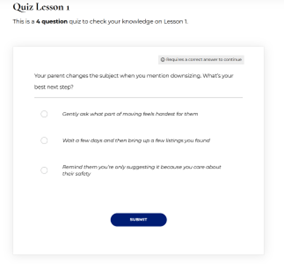
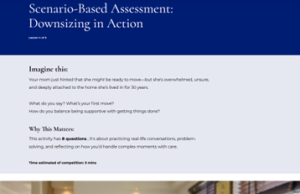
Assessments in this module are designed to be reflective, scenario-based, and practical. Learners will engage in:
- A scenario-based decision activity, where they choose how to respond to a sensitive conversation with their parents. Feedback is immediate and focuses on respectful communication.
- Self-reflection prompts asking what stands out most about their parent’s current situation (pictured). This encourages deep processing of what they’ve learned.
- knowledge checks where learners receive clear feedback for right and wrong answers.
- A final interactive planning activity where learners build a personalized 6-month downsizing plan, supported by a downloadable worksheet. This serves as both a summative task and a real-world takeaway.
Each learning objective is aligned with a specific interaction:
LT 1: Identify key considerations when supporting a parent through the downsizing process. It is measured trough self-reflection prompts and the multiple-choice knowledge check.
LT 2: Assess a current living situation to determine downsizing needs and opportunities. It’s measured through Scenario-based assessment: “Downsizing in Action” where learners apply decision-making in a realistic conversation about readiness and support. Also, the Walkthrough questions and red flag sorting.
LT 3: Develop a personalized downsizing plan that outlines priorities, timelines, and support resources. It’s measured through the 6-Month Downsizing Plan and “Who Is in Your Team?” worksheet.
In addition, a self-assessment checklist at the end allows learners to reflect on the clarity, pacing, and empathy in their plan connecting directly to the course’s success criteria.
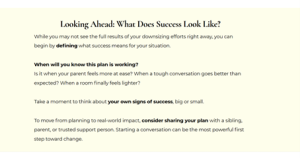
To evaluate the effectiveness of my practicum course, I applied Kirkpatrick’s 4 Levels of Evaluation. At Level 1 (Reaction), I included a post-module feedback survey in Rise to gather learner input on course satisfaction and relevance. Learners are asked whether the course was helpful, easy to follow, and applicable to their situation. At Level 2 (Learning), I measured knowledge and confidence using scenario-based assessments, reflection prompts, and short quizzes that align directly with the course learning objectives. For Level 3 (Behavior), I designed the final activity to be a real-world task: learners build a personalized 6-month downsizing plan and complete tools like the “Who’s In Your Team?” worksheet and action-oriented checklists. These allow learners to immediately apply what they’ve learned. Although Level 4 (Results) is more difficult to capture in a practicum setting, I planted the seed by asking learners to define their own success indicators ( “How will you know your plan is working?”) and encouraged them to share their plan with siblings or parents to create real change. Together, these strategies ensure the course supports both immediate learning and long-term impact.
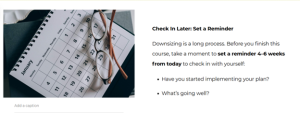
To further support Level 3 (Behavior) and encourage long-term application, I included a time-delayed assessment strategy. Learners are prompted to set a reminder or calendar event to check in with themselves 4–6 weeks after completing the course. At that time, they are encouraged to reflect on the progress they’ve made toward their 6-month downsizing plan. This delayed self-assessment supports real-world behavior change by reinforcing accountability and providing an opportunity to revisit and revise the plan as needed. If implemented through an LMS or email campaign in the future, this prompt could be delivered via an automated message to improve follow-through and capture valuable feedback on the course’s long-term impact.
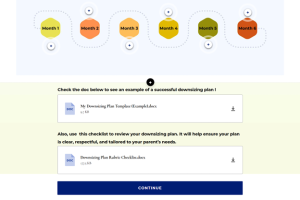
To support learners in successfully applying what they’ve learned, I provide a downloadable example downsizing plan and a rubric-style checklist they can use to evaluate their own. By reviewing a complete example, learners can see what success looks like, adapt ideas to their own situation, and avoid feeling overwhelmed by a blank worksheet. The checklist reinforces the course’s success criteria and encourages self-assessment. These tools reflect best practices in adult learning by reducing ambiguity, supporting independent application, and building learner confidence.
Media Attributions
- a
- b
- c
- d
- e
- g
- i
- j
- l
- aa
- m
- n
